2008 FORD SUPER DUTY weight
[x] Cancel search: weightPage 16 of 96
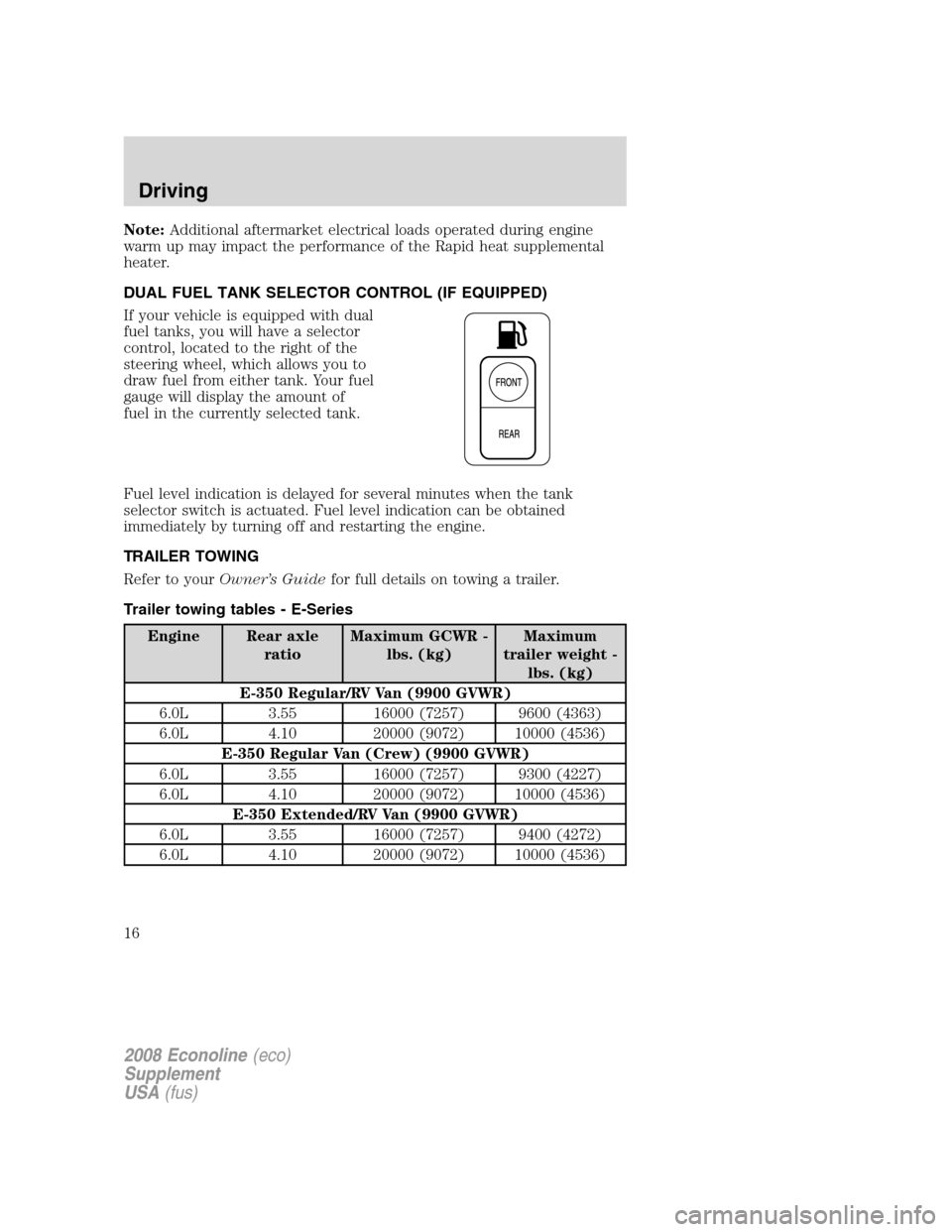
Note:Additional aftermarket electrical loads operated during engine
warm up may impact the performance of the Rapid heat supplemental
heater.
DUAL FUEL TANK SELECTOR CONTROL (IF EQUIPPED)
If your vehicle is equipped with dual
fuel tanks, you will have a selector
control, located to the right of the
steering wheel, which allows you to
draw fuel from either tank. Your fuel
gauge will display the amount of
fuel in the currently selected tank.
Fuel level indication is delayed for several minutes when the tank
selector switch is actuated. Fuel level indication can be obtained
immediately by turning off and restarting the engine.
TRAILER TOWING
Refer to yourOwner’s Guidefor full details on towing a trailer.
Trailer towing tables - E-Series
Engine Rear axle
ratioMaximum GCWR -
lbs. (kg)Maximum
trailer weight -
lbs. (kg)
E-350 Regular/RV Van (9900 GVWR)
6.0L 3.55 16000 (7257) 9600 (4363)
6.0L 4.10 20000 (9072) 10000 (4536)
E-350 Regular Van (Crew) (9900 GVWR)
6.0L 3.55 16000 (7257) 9300 (4227)
6.0L 4.10 20000 (9072) 10000 (4536)
E-350 Extended/RV Van (9900 GVWR)
6.0L 3.55 16000 (7257) 9400 (4272)
6.0L 4.10 20000 (9072) 10000 (4536)
2008 Econoline(eco)
Supplement
USA(fus)
Driving
16
Page 17 of 96
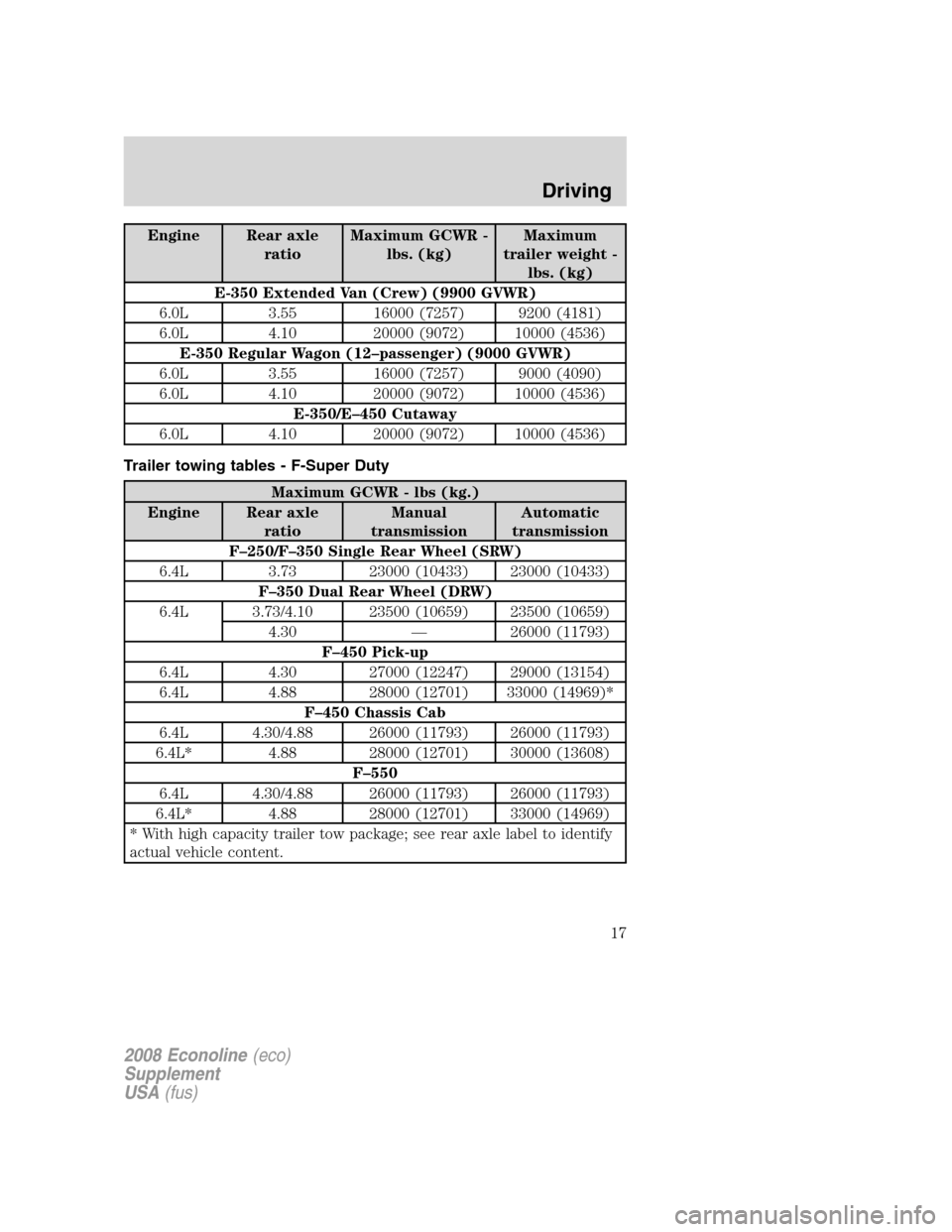
Engine Rear axle
ratioMaximum GCWR -
lbs. (kg)Maximum
trailer weight -
lbs. (kg)
E-350 Extended Van (Crew) (9900 GVWR)
6.0L 3.55 16000 (7257) 9200 (4181)
6.0L 4.10 20000 (9072) 10000 (4536)
E-350 Regular Wagon (12–passenger) (9000 GVWR)
6.0L 3.55 16000 (7257) 9000 (4090)
6.0L 4.10 20000 (9072) 10000 (4536)
E-350/E–450 Cutaway
6.0L 4.10 20000 (9072) 10000 (4536)
Trailer towing tables - F-Super Duty
Maximum GCWR - lbs (kg.)
Engine Rear axle
ratioManual
transmissionAutomatic
transmission
F–250/F–350 Single Rear Wheel (SRW)
6.4L 3.73 23000 (10433) 23000 (10433)
F–350 Dual Rear Wheel (DRW)
6.4L 3.73/4.10 23500 (10659) 23500 (10659)
4.30 — 26000 (11793)
F–450 Pick-up
6.4L 4.30 27000 (12247) 29000 (13154)
6.4L 4.88 28000 (12701) 33000 (14969)*
F–450 Chassis Cab
6.4L 4.30/4.88 26000 (11793) 26000 (11793)
6.4L* 4.88 28000 (12701) 30000 (13608)
F–550
6.4L 4.30/4.88 26000 (11793) 26000 (11793)
6.4L* 4.88 28000 (12701) 33000 (14969)
* With high capacity trailer tow package; see rear axle label to identify
actual vehicle content.
2008 Econoline(eco)
Supplement
USA(fus)
Driving
17
Page 18 of 96
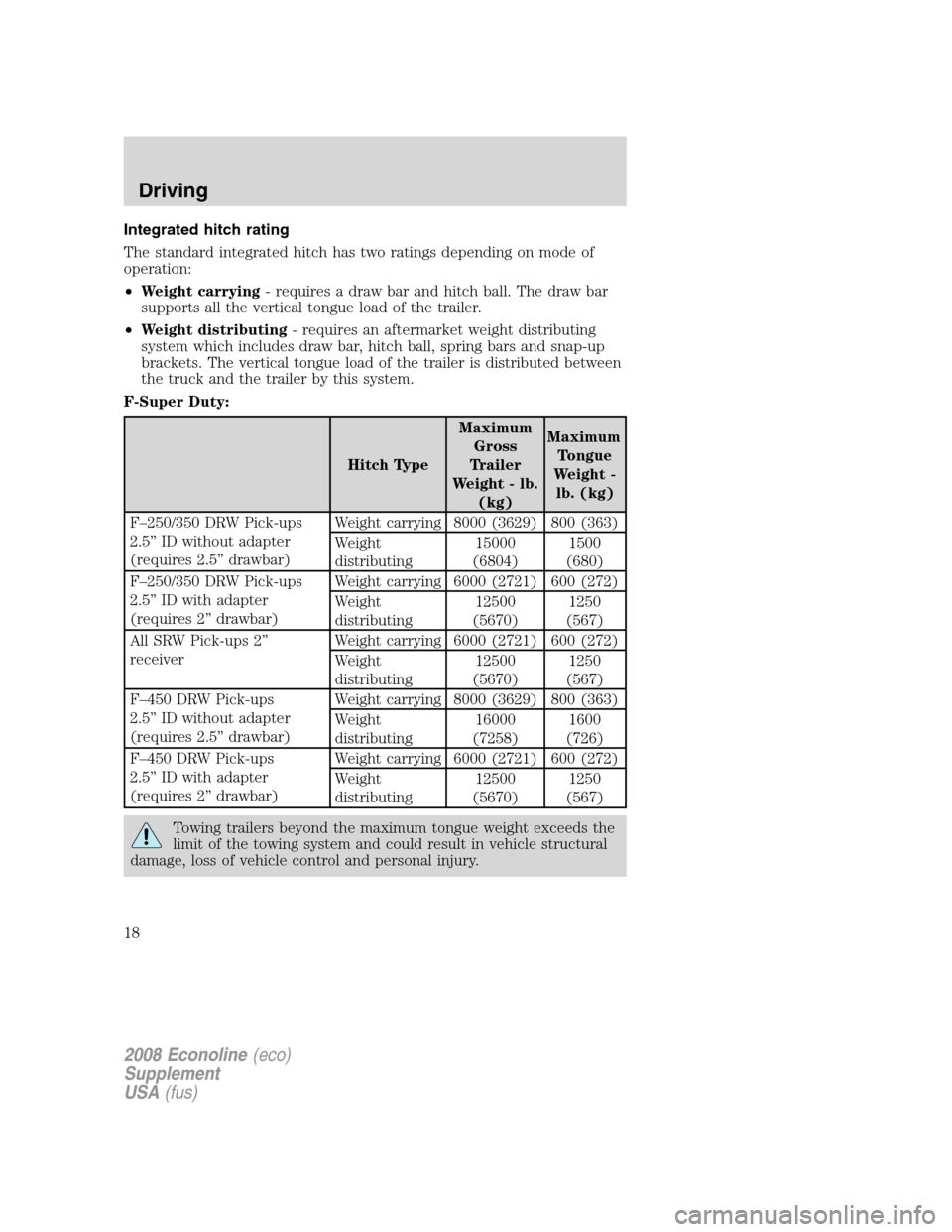
Integrated hitch rating
The standard integrated hitch has two ratings depending on mode of
operation:
•Weight carrying- requires a draw bar and hitch ball. The draw bar
supports all the vertical tongue load of the trailer.
•Weight distributing- requires an aftermarket weight distributing
system which includes draw bar, hitch ball, spring bars and snap-up
brackets. The vertical tongue load of the trailer is distributed between
the truck and the trailer by this system.
F-Super Duty:
Hitch TypeMaximum
Gross
Trailer
Weight - lb.
(kg)Maximum
Tongue
Weight -
lb. (kg)
F–250/350 DRW Pick-ups
2.5” ID without adapter
(requires 2.5” drawbar)Weight carrying 8000 (3629) 800 (363)
Weight
distributing15000
(6804)1500
(680)
F–250/350 DRW Pick-ups
2.5” ID with adapter
(requires 2” drawbar)Weight carrying 6000 (2721) 600 (272)
Weight
distributing12500
(5670)1250
(567)
All SRW Pick-ups 2”
receiverWeight carrying 6000 (2721) 600 (272)
Weight
distributing12500
(5670)1250
(567)
F–450 DRW Pick-ups
2.5” ID without adapter
(requires 2.5” drawbar)Weight carrying 8000 (3629) 800 (363)
Weight
distributing16000
(7258)1600
(726)
F–450 DRW Pick-ups
2.5” ID with adapter
(requires 2” drawbar)Weight carrying 6000 (2721) 600 (272)
Weight
distributing12500
(5670)1250
(567)
Towing trailers beyond the maximum tongue weight exceeds the
limit of the towing system and could result in vehicle structural
damage, loss of vehicle control and personal injury.
2008 Econoline(eco)
Supplement
USA(fus)
Driving
18
Page 42 of 96

operation includes extended periods of idling or low-speed operation,
driving for a long time in cold temperatures or driving short distances.
See the following sectionEngine lubrication for severe service
operationfor all severe duty restrictions.
Refer toMotorcraft Part Numberslater in this chapter for the engine oil
filter part number. This filter protects your engine by filtering harmful,
abrasive or sludge particles and particles significantly smaller than most
available “will-fit” filters.
To replace the filter,
1. Unscrew the oil filter cap and wait a few seconds for the oil to drain
through the built-in drain valve.Note:The filter should be changed
before reinstalling the oil pan drain plug.
2. Reinstall and tighten the oil filter cap.
Do not handle a hot oil filter with bare hands.
Continuous contact with USED motor oil has caused cancer in
laboratory mice. Protect your skin by washing with soap and
water.
Engine lubrication for severe service operation
The following severe service operating conditions require unique engine
maintenance procedures:
•frequent or extended idling (over 10 minutes per hour of normal
driving).
•if vehicle is operated in sustained ambient temperatures below -10°F
(-23°C) or above 100°F (38°C)
•frequent low speed operation, consistent heavy traffic less than 25
mph (40 km/h)
•operating in severe dust conditions.
•towing a trailer over 1,000 miles (1,600 km)
•sustained, high speed driving at Gross Vehicle Weight Rating
(maximum loaded weight for vehicle operation)
If you are operating your vehicle under any of these conditions, change
engine oil and filter every 5,000 miles (8,000 km).
2008 Econoline(eco)
Supplement
USA(fus)
Maintenance and Specifications
42
Page 49 of 96
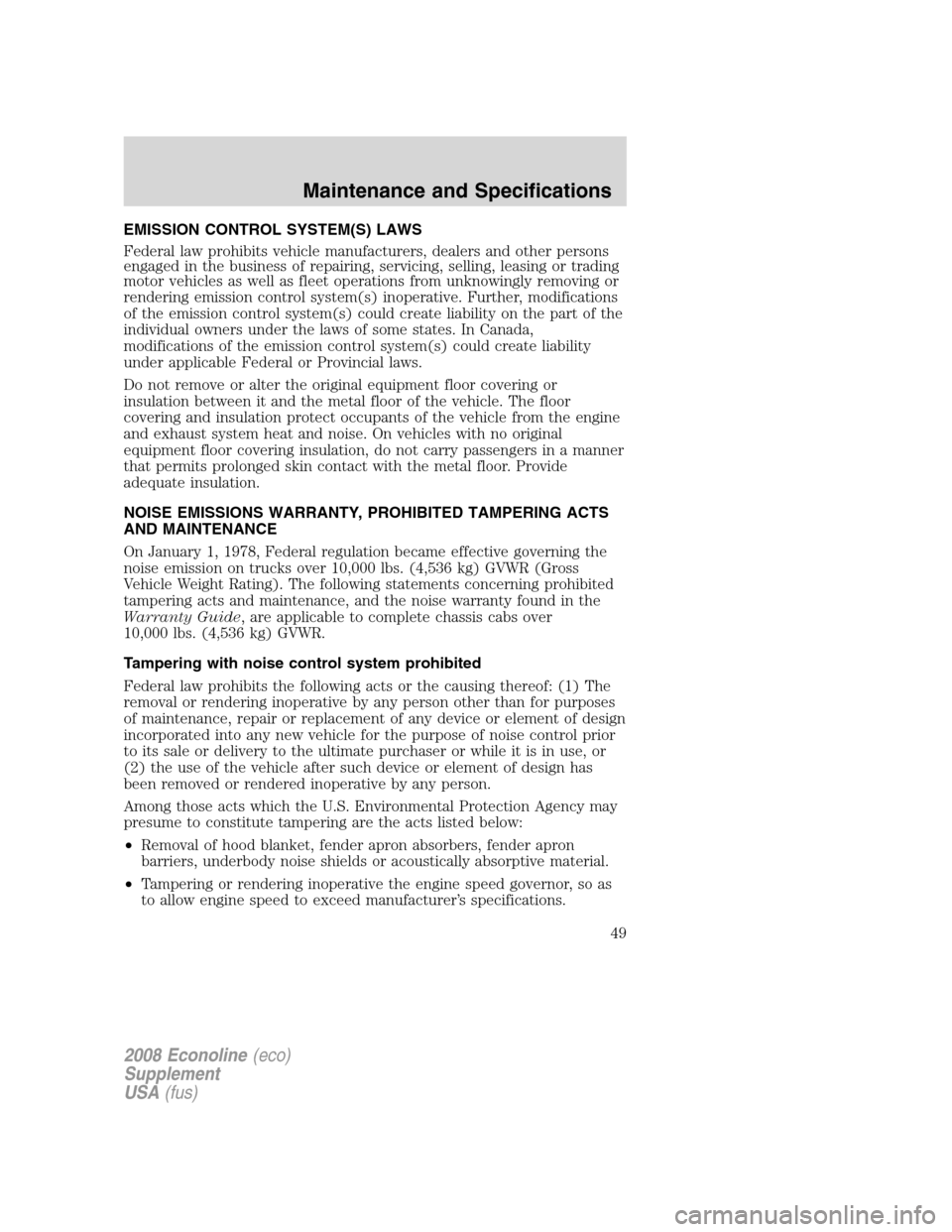
EMISSION CONTROL SYSTEM(S) LAWS
Federal law prohibits vehicle manufacturers, dealers and other persons
engaged in the business of repairing, servicing, selling, leasing or trading
motor vehicles as well as fleet operations from unknowingly removing or
rendering emission control system(s) inoperative. Further, modifications
of the emission control system(s) could create liability on the part of the
individual owners under the laws of some states. In Canada,
modifications of the emission control system(s) could create liability
under applicable Federal or Provincial laws.
Do not remove or alter the original equipment floor covering or
insulation between it and the metal floor of the vehicle. The floor
covering and insulation protect occupants of the vehicle from the engine
and exhaust system heat and noise. On vehicles with no original
equipment floor covering insulation, do not carry passengers in a manner
that permits prolonged skin contact with the metal floor. Provide
adequate insulation.
NOISE EMISSIONS WARRANTY, PROHIBITED TAMPERING ACTS
AND MAINTENANCE
On January 1, 1978, Federal regulation became effective governing the
noise emission on trucks over 10,000 lbs. (4,536 kg) GVWR (Gross
Vehicle Weight Rating). The following statements concerning prohibited
tampering acts and maintenance, and the noise warranty found in the
Warranty Guide, are applicable to complete chassis cabs over
10,000 lbs. (4,536 kg) GVWR.
Tampering with noise control system prohibited
Federal law prohibits the following acts or the causing thereof: (1) The
removal or rendering inoperative by any person other than for purposes
of maintenance, repair or replacement of any device or element of design
incorporated into any new vehicle for the purpose of noise control prior
to its sale or delivery to the ultimate purchaser or while it is in use, or
(2) the use of the vehicle after such device or element of design has
been removed or rendered inoperative by any person.
Among those acts which the U.S. Environmental Protection Agency may
presume to constitute tampering are the acts listed below:
•Removal of hood blanket, fender apron absorbers, fender apron
barriers, underbody noise shields or acoustically absorptive material.
•Tampering or rendering inoperative the engine speed governor, so as
to allow engine speed to exceed manufacturer’s specifications.
2008 Econoline(eco)
Supplement
USA(fus)
Maintenance and Specifications
49
Page 88 of 96

Sustained high-speed driving at Gross Vehicle Weight Rating (maximum
loaded weight for vehicle operation)
Every 5,000 miles (8,000 km) or 6
monthsChange engine oil and replace filter
Every 5,000 miles (8,000 km)Inspect and rotate tires (if required)
Inspect and lubricate steering and suspension ball joints
and tie rod ends (if equipped with zerk fittings)
Inspect brake system pads and rotors
Every 10,000 miles (16,000 km) or
400 hours of engine operation
(whichever comes first)Change engine-mounted fuel filter and chassis-mounted
(HFCM) fuel filter
Every 50,000 miles (80,000 km)Change rear axle lubricant
Every 60,000 miles (96,000 km)Change transfer case fluid (4x4 only)
Use of Biodiesel, up to and including 5% Biodiesel (B5)
Every 10,000 miles (16,000 km), 6
months or 400 hours of operation
(which ever comes first)Replace engine-mounted fuel filter and chassis-mounted
(HFCM) fuel filter
2008 Econoline(eco)
Supplement
USA(fus)
Scheduled Maintenance: F-Super Duty
88
Page 91 of 96
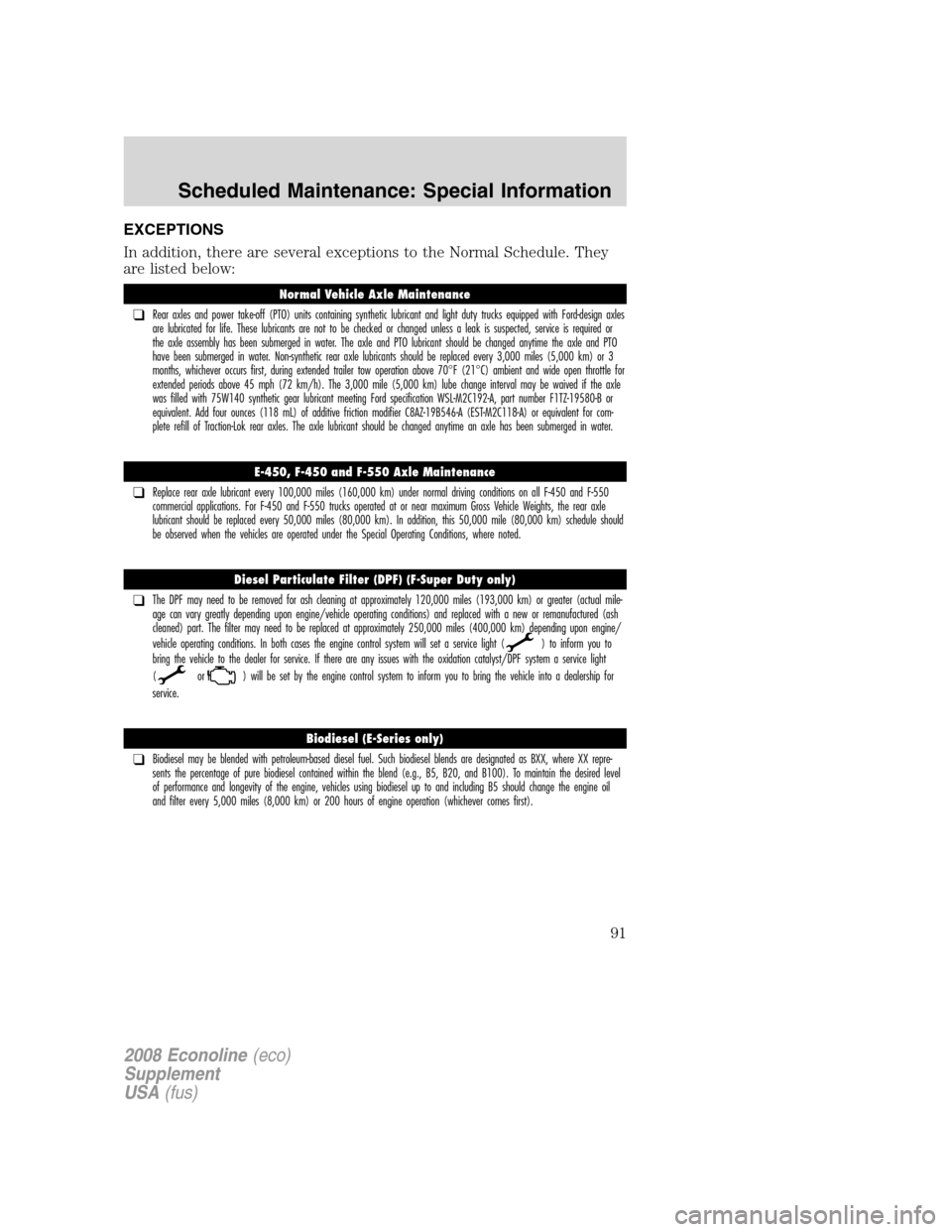
EXCEPTIONS
In addition, there are several exceptions to the Normal Schedule. They
are listed below:
Normal Vehicle Axle Maintenance
❑Rear axles and power take-off (PTO) units containing synthetic lubricant and light duty trucks equipped with Ford-design axles
are lubricated for life. These lubricants are not to be checked or changed unless a leak is suspected, service is required or
the axle assembly has been submerged in water. The axle and PTO lubricant should be changed anytime the axle and PTO
have been submerged in water. Non-synthetic rear axle lubricants should be replaced every 3,000 miles (5,000 km) or 3
months, whichever occurs first, during extended trailer tow operation above 70°F (21°C) ambient and wide open throttle for
extended periods above 45 mph (72 km/h). The 3,000 mile (5,000 km) lube change interval may be waived if the axle
was filled with 75W140 synthetic gear lubricant meeting Ford specification WSL-M2C192-A, part number F1TZ-19580-B or
equivalent. Add four ounces (118 mL) of additive friction modifier C8AZ-19B546-A (EST-M2C118-A) or equivalent for com-
plete refill of Traction-Lok rear axles. The axle lubricant should be changed anytime an axle has been submerged in water.
E-450, F-450 and F-550 Axle Maintenance
❑Replace rear axle lubricant every 100,000 miles (160,000 km) under normal driving conditions on all F-450 and F-550
commercial applications. For F-450 and F-550 trucks operated at or near maximum Gross Vehicle Weights, the rear axle
lubricant should be replaced every 50,000 miles (80,000 km). In addition, this 50,000 mile (80,000 km) schedule should
be observed when the vehicles are operated under the Special Operating Conditions, where noted.
Diesel Particulate Filter (DPF) (F-Super Duty only)
❑The DPF may need to be removed for ash cleaning at approximately 120,000 miles (193,000 km) or greater (actual mile-
age can vary greatly depending upon engine/vehicle operating conditions) and replaced with a new or remanufactured (ash
cleaned) part. The filter may need to be replaced at approximately 250,000 miles (400,000 km) depending upon engine/
vehicle operating conditions. In both cases the engine control system will set a service light (
) to inform you to
bring the vehicle to the dealer for service. If there are any issues with the oxidation catalyst/DPF system a service light
(
or) will be set by the engine control system to inform you to bring the vehicle into a dealership for
service.
Biodiesel (E-Series only)
❑Biodiesel may be blended with petroleum-based diesel fuel. Such biodiesel blends are designated as BXX, where XX repre-
sents the percentage of pure biodiesel contained within the blend (e.g., B5, B20, and B100). To maintain the desired level
of performance and longevity of the engine, vehicles using biodiesel up to and including B5 should change the engine oil
and filter every 5,000 miles (8,000 km) or 200 hours of engine operation (whichever comes first).
2008 Econoline(eco)
Supplement
USA(fus)
Scheduled Maintenance: Special Information
91